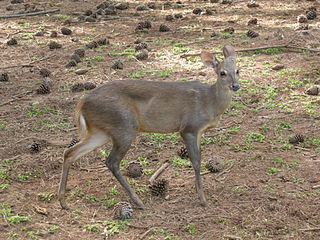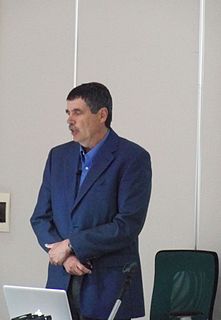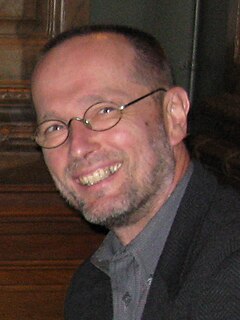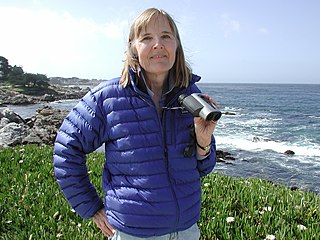
Theodosius Grygorovych Dobzhansky was a prominent Ukrainian-American geneticist and evolutionary biologist, and a central figure in the field of evolutionary biology for his work in shaping the modern synthesis. Dobzhansky was born in Ukraine, then part of the Russian Empire, and became an immigrant to the United States in 1927, aged 27.

The swift fox is a small light orange-tan fox around the size of a domestic cat found in the western grasslands of North America, such as Montana, Colorado, New Mexico, Kansas, Oklahoma and Texas. It also lives in Manitoba, Saskatchewan and Alberta in Canada, where it was previously extirpated. It is closely related to the kit fox and the two species are sometimes known as subspecies of Vulpes velox because hybrids of the two species occur naturally where their ranges overlap.

George Ledyard Stebbins Jr. was an American botanist and geneticist who is widely regarded as one of the leading evolutionary biologists of the 20th century. Stebbins received his Ph.D. in botany from Harvard University in 1931. He went on to the University of California, Berkeley, where his work with E. B. Babcock on the genetic evolution of plant species, and his association with a group of evolutionary biologists known as the Bay Area Biosystematists, led him to develop a comprehensive synthesis of plant evolution incorporating genetics.

Sewall Green Wright was an American geneticist known for his influential work on evolutionary theory and also for his work on path analysis. He was a founder of population genetics alongside Ronald Fisher and J. B. S. Haldane, which was a major step in the development of the modern synthesis combining genetics with evolution. He discovered the inbreeding coefficient and methods of computing it in pedigree animals. He extended this work to populations, computing the amount of inbreeding between members of populations as a result of random genetic drift, and along with Fisher he pioneered methods for computing the distribution of gene frequencies among populations as a result of the interaction of natural selection, mutation, migration and genetic drift. Wright also made major contributions to mammalian and biochemical genetics.
Oliver Perry Hay was an American herpetologist, ichthyologist, and paleontologist.

Brockets or brocket deer are the species of deer in the genus Mazama. They are medium to small in size, and are found in the Yucatán Peninsula, Central and South America, and the island of Trinidad. Most species are primarily found in forests. They are superficially similar to the African duikers and the Asian muntjacs, but unrelated. About 10 species of brocket deer are described.

Pampas deer is a species of Deer that live in the grasslands of South America at low elevations. They are known as venado or gama in Spanish and as veado-campeiro in Portuguese. Their habitat includes water and hills, often with winter drought, and grass that is high enough to cover a standing deer. Many of them live on the Pantanal wetlands, where there are ongoing conservation efforts, and other areas of annual flooding cycles. Human activity has changed much of the original landscape. They are known to live up to 12 years in the wild, longer if captive, but are threatened due to over-hunting and habitat loss. Many people are concerned over this loss, because a healthy deer population means a healthy grassland, and a healthy grassland is home to many species, some also threatened. Many North American birds migrate south to these areas, and if the Pampas deer habitat is lost, they are afraid these bird species will also decline. There are approximately 80,000 Pampas deer total, with the majority of them living in Brazil.
Edgar Shannon Anderson was an American botanist. His 1949 book Introgressive Hybridization was an original and important contribution to botanical genetics.

John Charles Avise is an American evolutionary geneticist, conservationist, ecologist and natural historian. He is a Distinguished Professor of Ecology & Evolution, University of California, Irvine, and was previously a Distinguished Professor of Genetics at the University of Georgia.

Beatrice Mintz is an American embryologist who has contributed to the understanding of genetic modification, cellular differentiation and cancer, particularly melanoma.Mintz was a pioneer of genetic engineering techniques, and was among the first scientists to generate both chimeric and transgenic mammals.

Günter P. Wagner is Alison Richard Professor of Ecology and Evolutionary biology at Yale University, and head of the Wagner Lab.
Jon Allen Seger is an American evolutionary ecologist, and Distinguished Professor of Biology at the University of Utah. He helped develop the theory of bet-hedging in biology. His work has appeared in leading scientific journals such as Nature, Science, Nature Genetics, Molecular Biology and Evolution, Journal of Evolutionary Biology, as well as popular magazines such as Scientific American.
John L. Koprowski, Professor, School of Natural Resources and the Environment, University of Arizona, mammalogist, conservation biologist, and leading expert on the ecology and conservation of squirrels, was born in 1961 in Lakewood, Ohio.

Katherine S. Ralls is an American zoologist and conservationist who is Senior Research Zoologist Emerita at the Smithsonian Conservation Biology Institute, National Zoological Park. Ralls' research interests are in the behavioral ecology, genetics, and conservation of mammals, both terrestrial and marine. Since 1980, she has focused on conservation biology, especially the genetic problems of small captive and wild populations.
Tyson Royal Roberts is an American ichthyologist. He has been described as "the world's foremost authority on Regalecus".
Don Ellis Wilson is an American zoologist. His main research field is the mammalogy, especially the group of bats which he studied in 65 countries around the world.
Amitabh Joshi is an Indian evolutionary biologist, geneticist and a professor at Jawaharlal Nehru Centre for Advanced Scientific Research (JNCASR). He heads the Evolutionary Biology Laboratory at JNCASR and is known for his studies on Genetics and Population ecology. An elected fellow of the Indian Academy of Sciences, National Academy of Sciences, India, and Indian National Science Academy, he is also a J. C. Bose National Fellow of the Department of Science and Technology. The Council of Scientific and Industrial Research, the apex agency of the Government of India for scientific research, awarded him the Shanti Swarup Bhatnagar Prize for Science and Technology, one of the highest Indian science awards, in 2009, for his contributions to biological sciences.
Walter John Emil Kress is an American botanist and the vice-president for science at the National Museum of Natural History. He currently holds the appointment (2010) as the Director of the new Consortium for Understanding and Sustaining a Biodiverse Planet at the Smithsonian and is the former Executive Director of the Association for Tropical Biology and Conservation.














